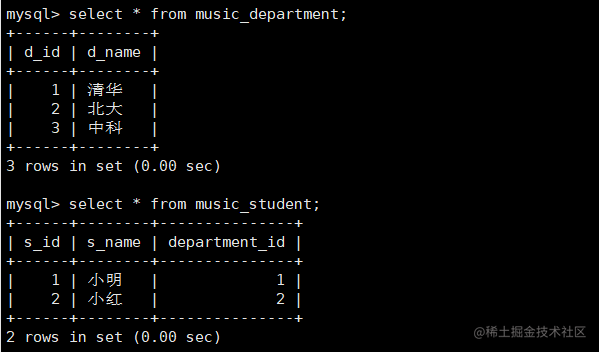from django.http import HttpResponse
from .models import Department,Student,Course,Stu_detail
def add_user(request):
d = Department.objects.get(d_id=1)
Student.objects.create(s_name="小明",department=d)
Student.objects.create(s_name="小红", department_id=2)
return HttpResponse("插入数据成功!")
③观察可知插入成功:
(2)表关联对象的访问:
①基操——普通方式
②进阶——正向查询
(注意点:凡是在模型类定义阶段设置了外键的属性,对应生成数据表时都会在其后加上_id。如果想单纯获取这个值,可以就数据库层面查询,使用.此属性_id即可)
正向查询:Student的模型类中我们有定义department的属性,所以当我们去访问的时候,可以直接通过student.department的形式去找到某个学生所属学院的实例对象,进而查询其所属学院的所有信息。
由此发出灵魂拷问:
如果我们也希望在在访问某个学院的实例对象的学生的时候该怎么访问呢???
这就用到了接下来要讲的——反向查询!!!
③终极版——反向查询
反向查询:如果模型Student有一个ForeignKey(会自动给对应的Department类添加一个反向查询的属性!),那么该ForeignKey 所指的模型Department实例可以通过一个管理器回到前面有ForeignKey的模型Studnet的所有实例。默认情况下,这个管理器的名字为student_set(可以在对应的表关联API中通过设置related_name的值来自定义),其中student是源模型的小写名称。
拓展:两个表关联的API(OneToOne,Foreignkey,ManyToMany)在谁那,通过谁去查询另一个表的信息就是正向查询;反之就是反向查询。
注意:只限一对多以及多对多;一对一没有_set属性,无法使用!!!
可以在定义时设置related_name 参数来覆盖student_set的名称!
③.1 终极版——反向查询的一些常用方法
注意:只限一对多以及多对多;一对一没有_set属性,无法使用!!!
from django.http import HttpResponse
from .models import Department,Student,Course,Stu_detail
def add_user(request):
d = Department.objects.get(d_id=1)
d3 = Department.objects.get(d_id=3)
d.student_set.create(s_name="小王")
s3 = Student.objects.get(s_id=2)
d3.student_set.add(s3)
return HttpResponse("插入数据成功!")
原始表中数据:
 访问上述视图函数对应接口后的数据:
访问上述视图函数对应接口后的数据:
④一对一表信息的访问
(注意:一对一表关系中使用不了反向查询!!!)
from django.http import HttpResponse
from .models import Department,Student,Course,Stu_detail
def add_user(request):
s1 = Student.objects.get(s_id=1)
Stu_detail.objects.create(Student=s1, age=18, phone=123456)
print(s1.stu_detail)
print(dir(s1.stu_detail))
print(s1.stu_detail.age)
d = Stu_detail.objects.get(id=1)
print(d.Student)
print(d.Student.s_name)
return HttpResponse("插入数据成功!")
Stu_detail<age=18,phone=123456>
['DoesNotExist', 'MultipleObjectsReturned', 'Student', 'Student_id', '__class__', '__delattr__', '__dict__', '__dir__', '__doc__', '__eq__', '__format__', '__ge__', '__getattribute__', '__getstate__', '__gt__', '__hash__', '__init__', '__init_subclass__', '__le__', '__lt__', '__module__', '__ne__', '__new__', '__reduce__', '__reduce_ex__', '__repr__', '__setattr__', '__setstate__', '__sizeof__', '__str__', '__subclasshook__', '__weakref__', '_check_column_name_clashes', '_check_field_name_clashes', '_check_fields', '_check_id_field', '_check_index_together', '_check_indexes', '_check_local_fields', '_check_long_column_names', '_check_m2m_through_same_relationship', '_check_managers', '_check_model', '_check_model_name_db_lookup_clashes', '_check_ordering', '_check_property_name_related_field_accessor_clashes', '_check_single_primary_key', '_check_swappable', '_check_unique_together', '_do_insert', '_do_update', '_get_FIELD_display', '_get_next_or_previous_by_FIELD', '_get_next_or_previous_in_order', '_get_pk_val', '_get_unique_checks', '_meta', '_perform_date_checks', '_perform_unique_checks', '_save_parents', '_save_table', '_set_pk_val', '_state', 'age', 'check', 'clean', 'clean_fields', 'date_error_message', 'delete', 'from_db', 'full_clean', 'get_deferred_fields', 'id', 'objects', 'phone', 'pk', 'prepare_database_save', 'refresh_from_db', 'save', 'save_base', 'serializable_value', 'unique_error_message', 'validate_unique']
Student<s_id=1,s_name=小明>
⑤多对多表信息的操作
第一部分:数据的添加及关联:
首先,课程表中添加数据:
from django.http import HttpResponse
from .models import Department,Student,Course,Stu_detail
def add_user(request):
Course.objects.create(c_name="python")
Course.objects.create(c_name="java")
Course.objects.create(c_name="web前端")
Course.objects.create(c_name="c++")
return HttpResponse("插入数据成功!")
此时,学生表也有了,下面要做的就是通过中间表将两个表关联起来!
然后,关联表:
from django.http import HttpResponse
from .models import Department,Student,Course,Stu_detail
def add_user(request):
s1 = Student.objects.get(s_id=1)
s2 = Student.objects.get(s_id=2)
c1 = Course.objects.get(c_id=1)
s1.course.add(c1)
s2.course.create(c_name="人工智能")
return HttpResponse("插入数据成功!")
没有执行之前Django自动生成的中间表是空的:
执行之后Django自动生成的中间表:
第二部分:指定数据的删除及全部删除
from django.http import HttpResponse
from .models import Department,Student,Course,Stu_detail
def add_user(request):
s1 = Student.objects.get(s_id=1)
s2 = Student.objects.get(s_id=2)
c1 = Course.objects.get(c_id=1)
s1.course.remove(c1)
s2.course.clear()
return HttpResponse("插入数据成功!")
(注意对于所有类型的关联字段,add()、create()、remove()和clear()都会马上更新数据库。换句话说,在关联的任何一端,都不需要再调用save()方法)